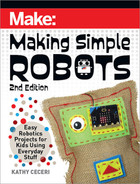
ROBOTS INSPIRED
BY NATURE
#1
Cover Page “i”
Preface Intro Chap 1
Xxxxxx Chap 3
Chap 3 Chap 5 Chapter 2
Explore soft robotics with models
that take after living things!
Make_Simple_Robots_interior_FIN.indd 22Make_Simple_Robots_interior_FIN.indd 22 4/26/22 1:53 PM4/26/22 1:53 PM

Do you ever think about what robots are made of? A robot’s body needs to
fit its job. And since robots can do so many different things, scientists are
always looking for ways to create bodies that will help the robot do what it
needs to do!
In old science fiction movies, robots were always big, heavy, and blocky. To
show off how powerful they were, their bodies were made of metal. Even
human-shaped robots looked kind of like factory machinery. In the real
world, household robots like robo-vacuums and robotic toys are usually
made of plastic. Their bodies are smaller and lighter, but still strong and
hard to damage.
However, one branch of robotics is focused on a different way of building
robots. Soft robots can bend, stretch, and squeeze themselves through tight
spots, just like a cat or an octopus. In fact, many soft robots are biomimetic,
which means they’re modeled after living things. Biomimetic robots copy
the way people and animals walk, crawl, swim, or fly. Since they’re based
upon millions of years of evolution, they can also be more efficient than
other robot designs. They may require less power and less programming
than hard-bodied, machine-like robots to get where they want to go.
Soft robots are also more compliant — a robotics term meaning they are
safe to use around people and delicate things. If your supermarket tried to
use a big metal robot arm to pack groceries, chances are it would end up
smushing the bananas and cracking the eggs. But if you gave the job to a
compliant robot hand, such as the fin gripper claw in this chapter, it would
gently close around each object.
Let’s start our robot adventures by creating some soft robotic prototypes
Make_Simple_Robots_interior_FIN.indd 1Make_Simple_Robots_interior_FIN.indd 1 4/26/22 1:53 PM4/26/22 1:53 PM

inspired by nature. The projects in this chapter are made with everyday
materials like stiff paper and twisty balloons. Paper makes a good material
for building robot models because it can be stiff enough to stand up, yet soft
enough to act like a spring when folded. Balloons are incredibly light — and
when they’re filled with air, they can also be incredibly strong.
You may be surprised how much these super-simple designs behave like
the real thing!
2
Making Simple Robots, 2nd Edition
Make_Simple_Robots_interior_FIN.indd 2Make_Simple_Robots_interior_FIN.indd 2 4/26/22 1:53 PM4/26/22 1:53 PM

Project: Make a Paper Walking Robot Dog
CREATE A GRAVITY-POWERED QUADRUPED FROM AN INDEX CARD
For this project, you’ll build a robot that moves without any computers or
sensors to guide it. In fact, this version is so basic, it doesn’t even need a
motor! Instead, it is powered by the pull of gravity. This style of motion is
known as passive dynamic walking.
Scientists used to think that people and animals relied on their brains to
control the way they walked and keep their balance. But it turns out that a
lot of that control is taken care of by the legs themselves — an example of
a smart body in action! The legs swing back and forth and shift the weight
of the body from side to side. Once they get started, the legs keep going
Chapter 1: Robots Inspired by Nature 3
Make_Simple_Robots_interior_FIN.indd 3Make_Simple_Robots_interior_FIN.indd 3 4/26/22 1:53 PM4/26/22 1:53 PM

forward until the brain tells them to stop. It’s an efficient and stable system,
which is why robotics engineers have borrowed it to use in walking robots.
Most passive dynamic walkers are bipeds and walk on two legs. When
they move, they shift all their weight to one leg, and let the other leg swing
forward. Then they shift their weight the other way to allow the other foot
to take a step. (Check out my book BOTS! to see how to make a two-legged
version.)
However, some robotics labs have tried making passive dynamic walkers
with three, four, or even more legs! The extra legs help with balance, but
they also make the pattern of walking much more complicated. When a dog
walks along, it only picks up one foot at a time. A cheetah or a race
horse can trot with two feet always on the ground at the same
time, or gallop with just one foot touching down as it speeds
by. Trying to get a four-legged robot to move in a realistic way
is a big problem scientists are still trying to solve.
One robot dog called Spot, made by Boston Dynamics, has a gait (or
pattern of walking) that’s so real, it’s spooky. Spot’s legs bend the same way
real dog legs bend. And with its sensors and programming, Spot is good at
getting itself back up if it tumbles over on its side. The Walking Robot Dog
you will be making, on the other hand, doesn’t even have knees, so its legs
don’t bend. But it does move one front foot and then the other in a slow,
steady rhythm as it makes its way downhill. It also has a long skinny neck
and a small head, like Spot. The head and tail help keep it balanced. Even
though it isn’t as advanced as Spot, it’s still pretty good at not falling over.
However, there is one engineering challenge you’ll have to solve: The
Walking Paper Robot Dog has no feet. That means it has very little traction
to keep it from sliding downhill. (Think about how the somewhat sticky
rubber on your sneakers, or a dog’s rough paw pads, help the feet grip the
floor.) You may need to find or add a bumpy or sticky texture to your test
ramp, or directly to the ends of your robot’s legs!
4
Making Simple Robots, 2nd Edition
Make_Simple_Robots_interior_FIN.indd 4Make_Simple_Robots_interior_FIN.indd 4 4/26/22 1:53 PM4/26/22 1:53 PM
..................Content has been hidden....................
You can't read the all page of ebook, please click here login for view all page.
